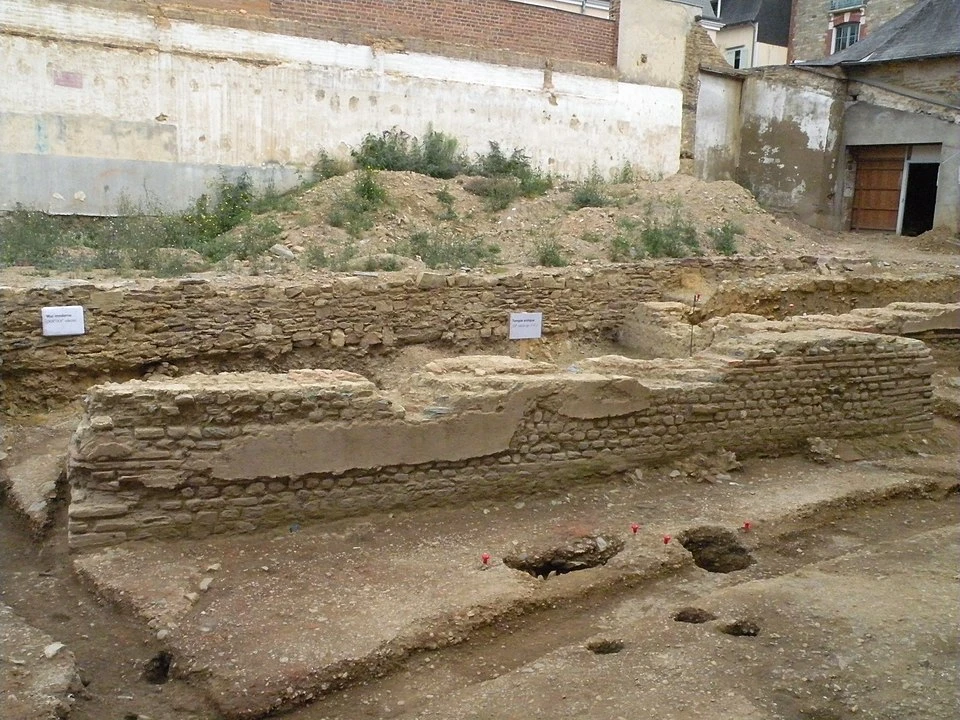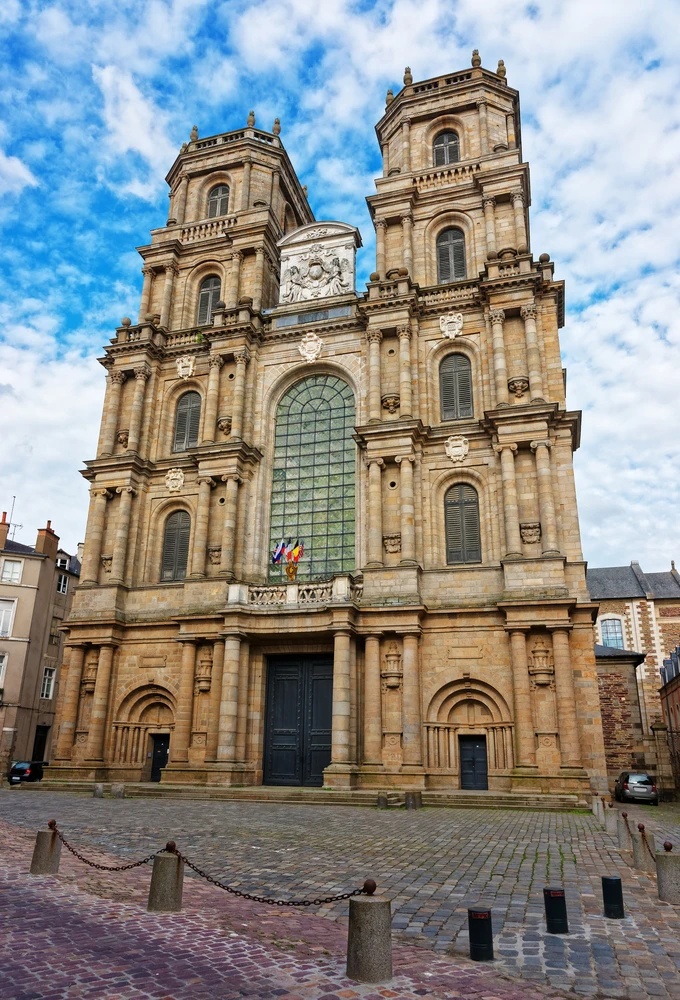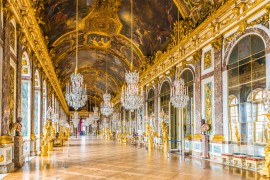What is Rennes like?
Rennes is a beautiful place.
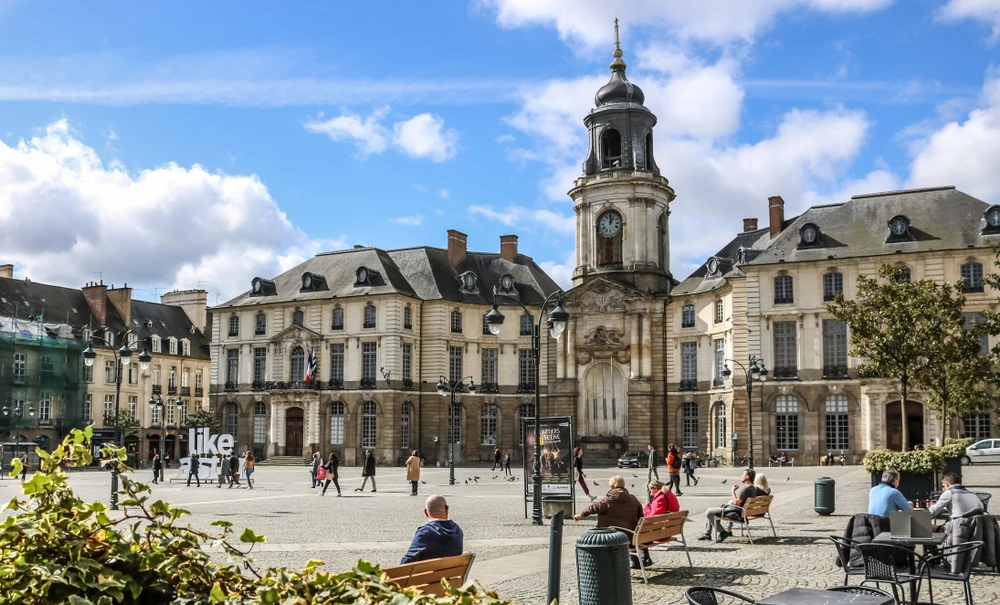 City hall of Rennes / Photo by AnnDcs/Shutterstock
City hall of Rennes / Photo by AnnDcs/Shutterstock
What strikes you in the city is the harmony. It is logical since the city burned down in the 17th century (see below) and was rebuilt with the first urban planning rules of its time. The city center has a series of pretty streets with granite arcades and upper facades in tufa stone which give it a lot of allure. The main shopping street, visited by anyone who shops in the city, is the so-called rue le Bastard (extended by the rue d'Estrée. But there are many stores in the adjacent streets, around the Parliament of Brittany, or on the southern banks of the Vilaine. The streets with arcades are sometimes extended by more sinuous streets with half-timbered houses. These houses are also found on the Place des Lices, the place of the market, so important and so warm, on Saturday morning.
The squares are very beautiful, especially the town hall square. A town hall with an amazing belfry, bulbous, which curves in its center, and which seems to answer to the opera, located just opposite, which advances a rounded frontage. The Place du Palais, the royal square par excellence, has a lot of allure. It offers very elegant facades with high windows and is a beautiful setting for the highlight of the show: the Palace of the Parliament of Brittany. Most of it burned down after a demonstration in 1994, it has been entirely renovated (and the most beautiful rooms were saved from the fire, so that you can visit places that have known 4 centuries of Breton history).
But it's mostly an atmosphere.
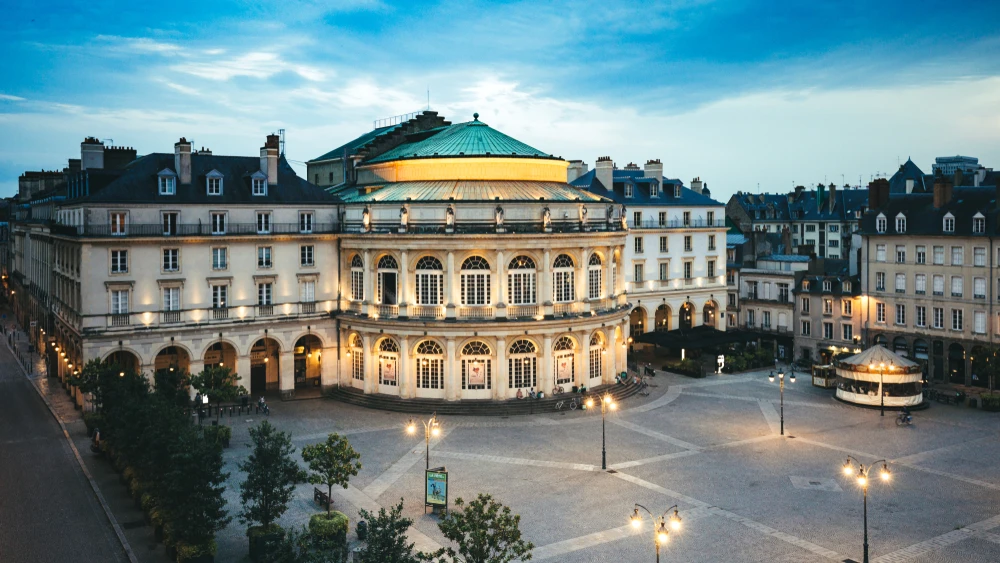 Opera of Rennes in front of the city-hall / Photo by lr.s/Shutterstock
Opera of Rennes in front of the city-hall / Photo by lr.s/Shutterstock
A youthful atmosphere. The city is student, very student... We meet young people everywhere and we feel comfortable in this city which is favourable to meetings and parties. Rennes is not Breton for nothing, one does not count any more the small bistros in downtown, in particular in the district Saint-Michel, towards the famous "street of the thirst" a long time the French street which counts the most bars. You can also get drunk in the bars of the Rue de Saint-Malo, towards the Rue Saint-Georges... It is also a very greedy city. It is very easy to find a good table, especially in creperie because the pancake (Pardon! Here, we say galette) it is the speciality of Brittany and that it is very appreciated here. We eat it for example at the market, or at the games of Roahzon Park in the form of "galette saucisse", a kind of Breton hot-dog, except that the bread is a galette. Delicious!
City of artists and curiosity

A city of concerts. In the bars, but also during the famous Transmusicales. Photo by Esther Tuttle on Unsplash
What is striking in Rennes is the love of curiosity. Artistic in particular. There are a lot of concert cafés, dynamic venues that launch many talents (the UBU for example). A curiosity that can be found in the Fine Arts Museum or the Museum of Brittany, but also in the university laboratories, but also during discussions that can arise spontaneously on the terrace. The people of Rennes do not "sulk", they are rather open to impromptu discussions, for example between neighbors on the terrace, you will see.
A history more than two thousand years old than that of Rennes
The "Condate" of the Gauls.
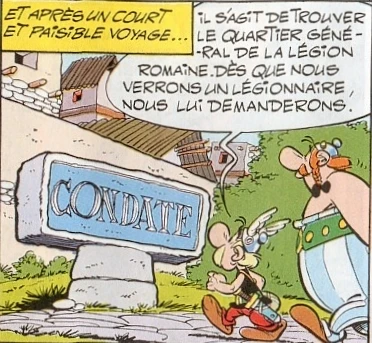
Condate as seen by Uderzo in "Asterix Legionnaire" / (c) Dargaud editions
It would have been born 2 centuries before Jesus Christ. "Condate" is how it is mentioned in Roman times, and it is under the name of Condate that we come across it in the adventures of Asterix and Obelix, who sometimes pass through Condate to begin an adventure. Condate means "the confluence" and it is indeed above the confluence, the meeting of two rivers: the Ille and the Vilaine, that the capital of the Gallic Riedonnes tribe was located. This is where the cathedral is today. It is named "Civitas Riedonum" on a stele of the 2nd century, in other words "the city of the Riedonnes". The Riedonians were a tribe whose name might have meant "the chariot drivers" and who occupied the equivalent of today's Ille-et-Vilaine department, minus the area around Saint-Malo and Redon.
The remains of the temple dedicated to Mars Juno and discovered during the renovation of the Centre des Jacobins / By VIGNERON - Personal work, CC BY 3.0, https://commons.wikimedia.org/w/index.php?curid=23780981
A small city, only 80 hectares, which is mainly a military city, but which is also a commercial place. It is nicknamed "the red city" because of the color of its ramparts made of bricks and stones from the Rennes region. These ramparts were very useful during the great invasions. The city became Frankish, but very close to the Bretons, and became truly Breton under the reign of the king of Brittany Erispoé in the year 851 when his victory against the French king Charles the Bald allowed him to take over Rennes and Nantes.
Rennes Capital of Brittany
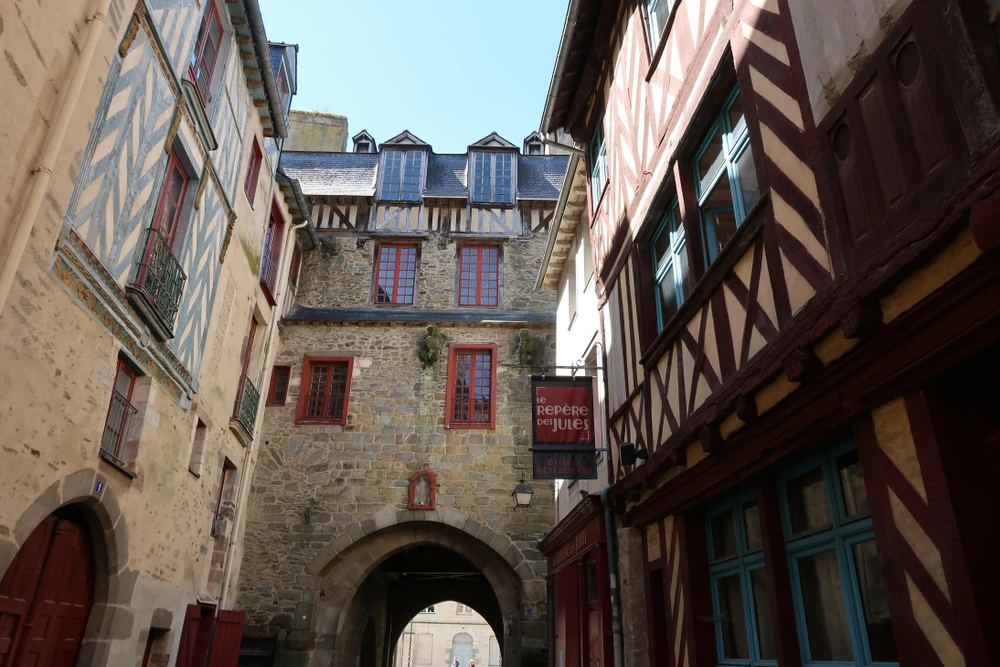 Les portes mordelaises à Rennes / Photo by Pascal_p10/Shutterstock
Les portes mordelaises à Rennes / Photo by Pascal_p10/Shutterstock
More and more important in the Middle Ages, Rennes grew three times by the construction of ramparts that first ran along the Vilaine, before crossing it and encompassing the south bank and the tanners' district (today's rue de la parcheminerie). It became the city of the coronation of the Dukes of Brittany. In front of the Mordelaise Gate (located on the road to Mordelles, an important stronghold), the Duke dismounted and dismounted to swear to preserve Breton liberties. It is only after having made this oath that he crosses the two drawbridges and passes under the gate before continuing towards the Saint-Pierre cathedral located just in front of him (and rebuilt several times in history, the last time in the 19th century). It is in Rennes that the young duchess Anne of Brittany was crowned at the age of 12 in 1489. It was there, too, in 1490, that she married Maximilian of Habsburg by proxy, triggering the anger of the French king Charles VIII who refused to allow Brittany to become Austrian and even decided to get his hands on it.
When Brittany became French
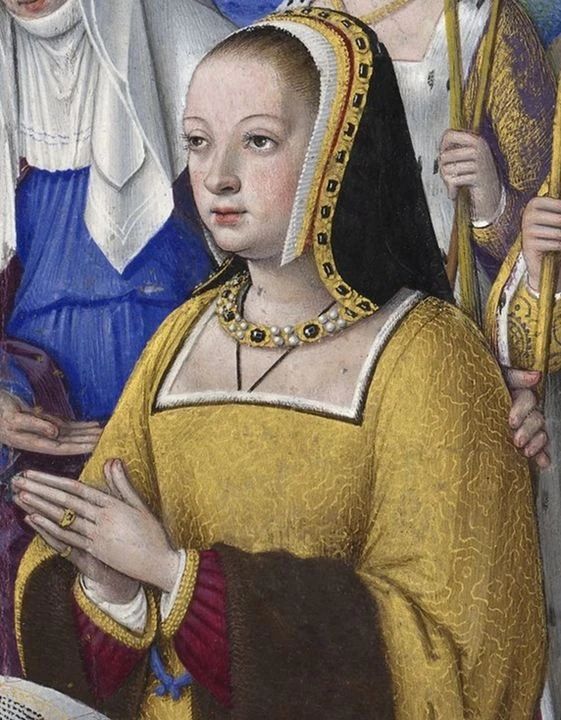
Anne of Brittany by Jean Bourdichon, detail of a miniature of the Great Hours of Anne of Brittany, around 1503-1508, BNF
During the two-month siege in 1491, the population of Rennes did everything possible to resist the assaults of the French, but it was clear that the city was not strong enough to resist the powerful armies of the French king, and Brittany's allies looked the other way. Rennes opened its doors to Charles VIII. It was agreed that Anne would marry Charles VIII, bringing her duchy of Brittany as a dowry. It is said that the engagement was celebrated in the Jacobin convent (which still exists, it has become the Palais des Congrès). Anne of Brittany married Charles VIII in 1491 in Langeais (Indre-et-Loire). Widowed, she married the successor of her first husband, Louis XII, and could not prevent the union of Brittany to France, which became definitive after her death in 1532. She was the only one who was twice Queen of France in history.
It is in Rennes, which became French, that the Parliament of Brittany was established, a court of justice, which officiated until the French Revolution and for which King Louis XIV built the Palace of the Parliament, a magnificent building designed by the architect Salomon de Brosse (already the author of the Palais des Tuileries in Paris). Begun in 1618, it was not completed until 1655, or even 1709 for the interior decorations. The building site was disrupted by numerous setbacks (epidemics, parliamentary rebellion).
1720: Rennes burns.
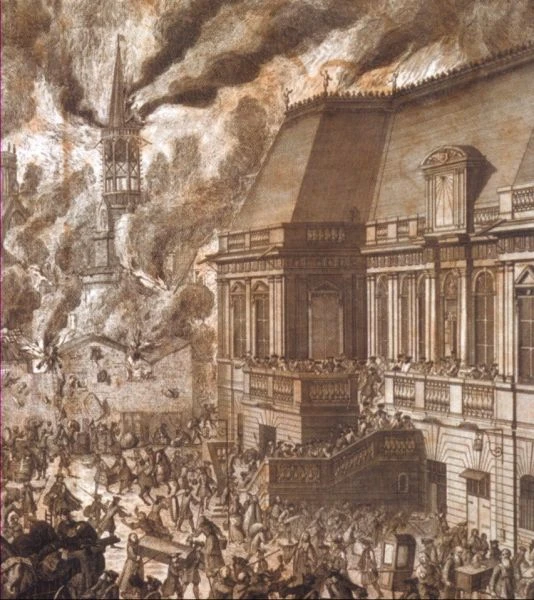
The fire of 1720 ravaged 40% of the city but did not destroy the Parliament of Brittany / by Jean-François Huguet - [1] but above all the digital collections of the Champs Libres
The 16th and 17th centuries saw Rennes grow and continue to build with wood, because, unlike many places in Brittany, stone was in short supply. They built with wood and earth, as can still be seen in the many magnificent private mansions on the Place des Lices, the Place du Champs Jacquet or the Rue Saint-Georges. A city made of wood is prone to fires and it will not fail.
On December 23, 1720, a carpenter named Henri Boutrouel, nicknamed "la cavée", completely drunk, during an argument with his wife, dropped a candle on a pile of wood shavings in the center of the city. This was the starting point of a fire that literally ravaged Rennes for a week. 40% of the city was destroyed. There was talk of 8,000 victims. Barracks were hastily built to house a few inhabitants along the ramparts. There are still some on the rue de la Visitation, proof that the temporary can last a long time in Brittany.
And it was completely rebuilt.
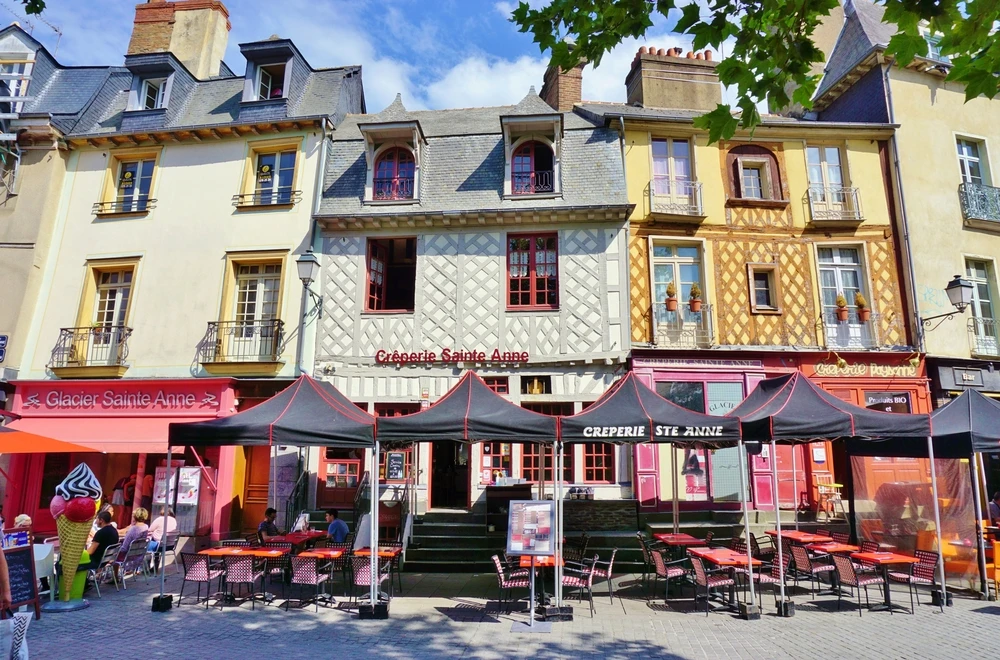 Some of the wooden houses were not destroyed by the great fire of 1720 and are typical of the center of the city, where many cafés and restaurants are located / Photo by EQRoy/Shutterstock
Some of the wooden houses were not destroyed by the great fire of 1720 and are typical of the center of the city, where many cafés and restaurants are located / Photo by EQRoy/Shutterstock
If we except the chapter district (around the cathedral) which did not burn down because the owner of the Hôtel de Blossac blocked the chapter street with his furniture to block the fire, or if we except the Saint-Georges street, or the Saint Melaine street, leading to the huge Saint Melaine abbey (of which the church and the cloister remain), the city is to be rebuilt in 1720. A first architect is chosen by the king Louis XV. His name was Isaac Robelin. He planned to rebuild the whole city (including what was not destroyed) in a very modern way, with right-angled streets and buildings. He also wanted to channel the Vilaine, which was capricious and often overflowed. He had a dog-like character and his project seemed too expensive, so he was dismissed. Only one house, on the Place du Parlement, bears witness to his work. The Vilaine was only canalized more than 100 years later, at twice its flow rate because it often overflows, which explains the height of the quays in relation to the flowing water.
It is the architect Jacques V Gabriel who is finally chosen and put to work. He was responsible for the Place de la Bourse in Bordeaux, a large part of the Château de Compiègne and the Saint-Louis cathedral in La Rochelle. He resumed Robelin's plan, with streets at right angles, and abandoned the canalization of the Vilaine. He created monumental squares, one in front of the Parliament, the other one in front of a double building that housed the presidial on the right, and on the left a brand new city hall that is still the one of Rennes today, with its amazing belfry with its bulbous bell tower topped by the golden lily of France. A niche was built on the façade to install a statue of Louis XV which was destroyed during the French Revolution. It is from this period that the city center of Rennes dates, so homogeneous, with its granite arcades and its white tufa floors.
19th and 20th century
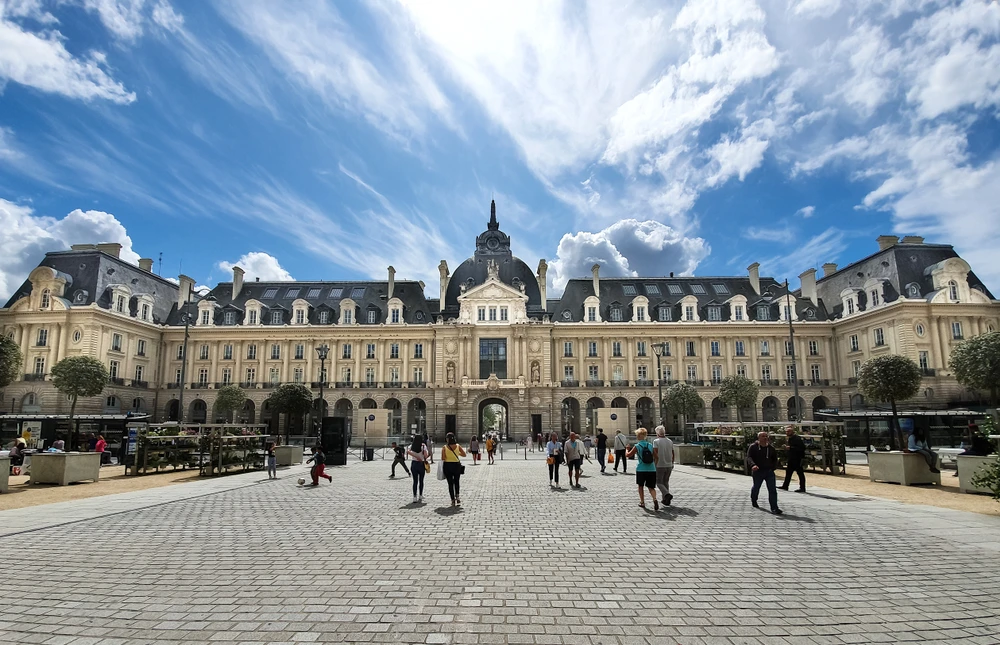 Le palais du commerce à Rennes / Photo by 365_visuals/Shutterstock
Le palais du commerce à Rennes / Photo by 365_visuals/Shutterstock
The prefecture of the department of Ille-et-Vilaine in 1790, Rennes became an important military city and many barracks were built in the 19th century. It was equipped with an arsenal that allowed to equip Brittany with weapons. It developed a lot with the arrival of the train in 1857. Taken by the Nazis on June 18th 1940, the city was liberated on August 4th 1944. It was bombed several times during the occupation and lost 655 inhabitants during the bombings of 1943 and 1944.
After the war, the city really took off with the arrival of industry, especially the automobile industry with the installation of Citroën in the 1970s. Students became very numerous and the city took on a youthful look that has never left it since.
New neighborhoods were created after Sainte Thérèse, Jeanne d'Arc and rue de Nantes. In the 1970s, the Villejean, Maurepas, Patton and southern neighborhoods were born. In the city center, the Bourg-l'évêque district was razed to the ground to build modern buildings, the flagship of which is called "Les Horizons" and has 32 floors and a height of 99.5 meters.) The city also became very commercial. Its downtown area was pedestrianized in 1977. It was equipped with a subway in 2002. A second line has just been added in 2022.
5 monuments to see in Rennes
1 the Parliament of Brittany
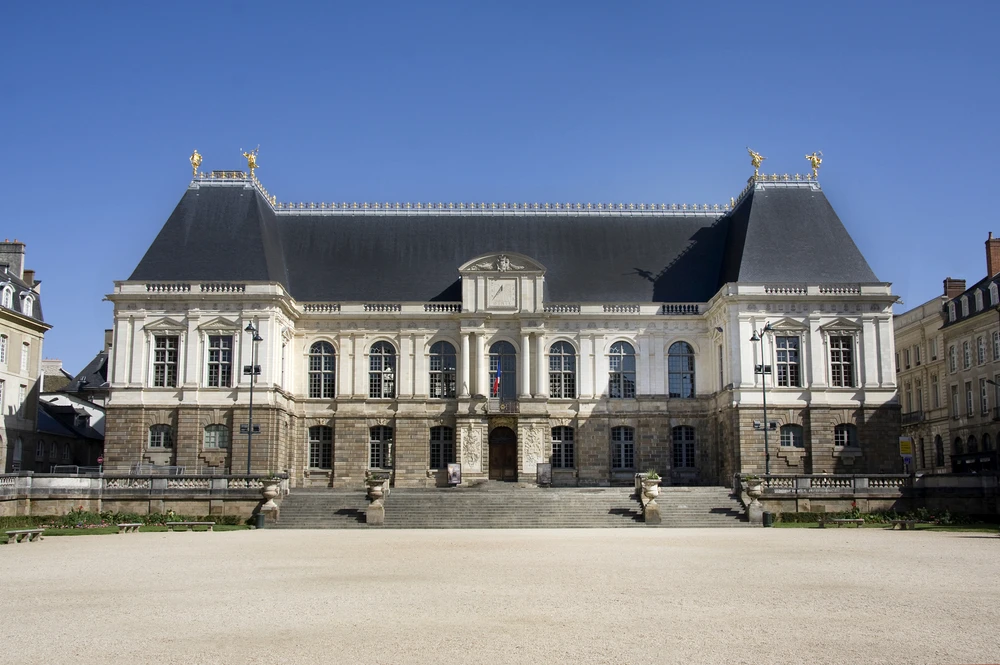 The Palace of the Parliament of Brittany. It is still a court of justice / Photo by Jane Rix/Shutterstock
The Palace of the Parliament of Brittany. It is still a court of justice / Photo by Jane Rix/Shutterstock
Built between 1618 and 1655, it was originally built against the city walls. The first plans were presented by Germain Gaultier, architect of the city in 1609, but they were refused and modified several times. In the end, he did not carry out the final construction because he died in an accident on the site. It is finally the architect Salomon de Brosse, architect of the Luxembourg palace for Marie de Médicis who draws the facades of the current building.
Its facade consists of a first floor in granite and a first floor in tufa. The roof is made of slate. If you look closely at this facade, you can see many symbols: scales, since justice was administered there (it is still the case today), crowned "Ls" since it was completed during the reign of Louis XIV, a sundial topped by the Arms of France with three fleurs-de-lis. On the roof, we can see the alternation of the fleur-de-lys of France and the ermine of Brittany, and in the four corners, golden statues representing Justice, Law, Force and Eloquence. Inside, the Great Chamber is decorated with paintings by Erard and Coypel and magnificent hangings.
2 The City Hall
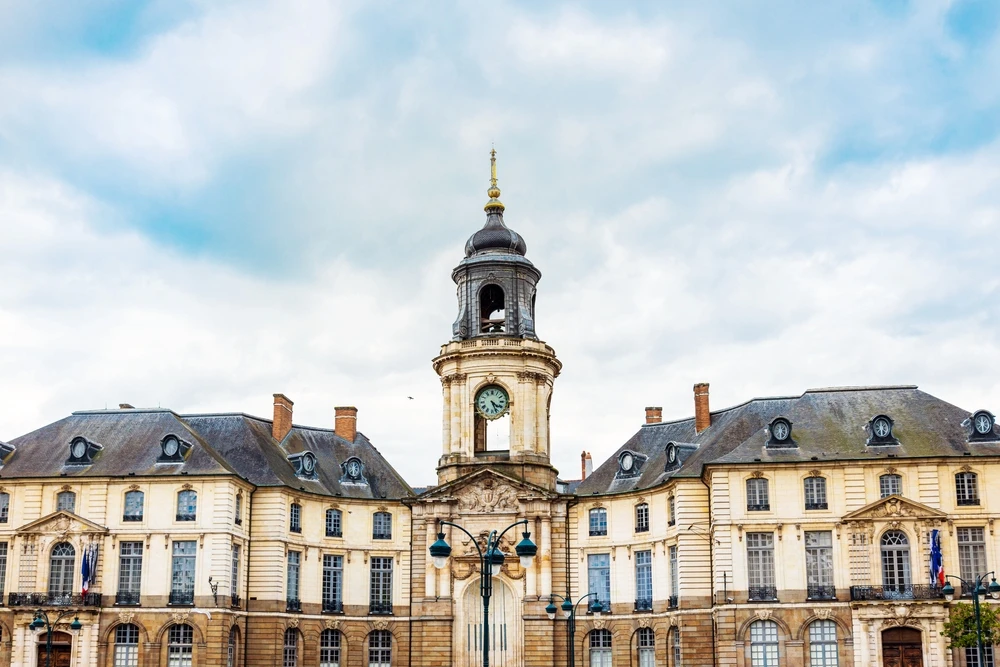 Rennes city hall (désignated by Gabriel) / Photo by ilolab/Shutterstock
Rennes city hall (désignated by Gabriel) / Photo by ilolab/Shutterstock
Everyone knows this place in the heart of the city and located on the passage of the many shoppers of the center. It consists of two buildings joined by a belfry. On the left the first city hall, on the right the former presidial, united into one city hall over time. Under the belfry, in the niche, there used to be a statue of Louis XV, which was destroyed during the Revolution. It was replaced by the sculptor Boucher in 1911 by a statue representing the union of Brittany with France in the form of Anne of Brittany kneeling before a woman representing France. Considered insulting to Brittany, it was dynamited during an attack and never replaced.
Behind you is the opera house, decorated with statues of Apollo and the 9 muses. Finally, further on, you can see the Palais du Commerce, an enormous building with a yellow-white facade that houses the post office and was built from 1885 to 1929, notably by the architect Martenot, who also built the city's market.
3 The Saint-Pierre Cathedral
Cathedral Saint Peter Rennes / Photo by Roman Babakin/Shutterstock
Rennes has known several cathedrals. The one we know is the latest one. It is the result of several centuries of work. The facade was started after the collapse of the Gothic facade. Begun in 1490, stopped several times, the building site was spread over 163 years, including a few years under Louis XIV, which can be seen with the coat of arms of France, and the motto of the Sun King "Nec pluribus impar" "no one can match it".
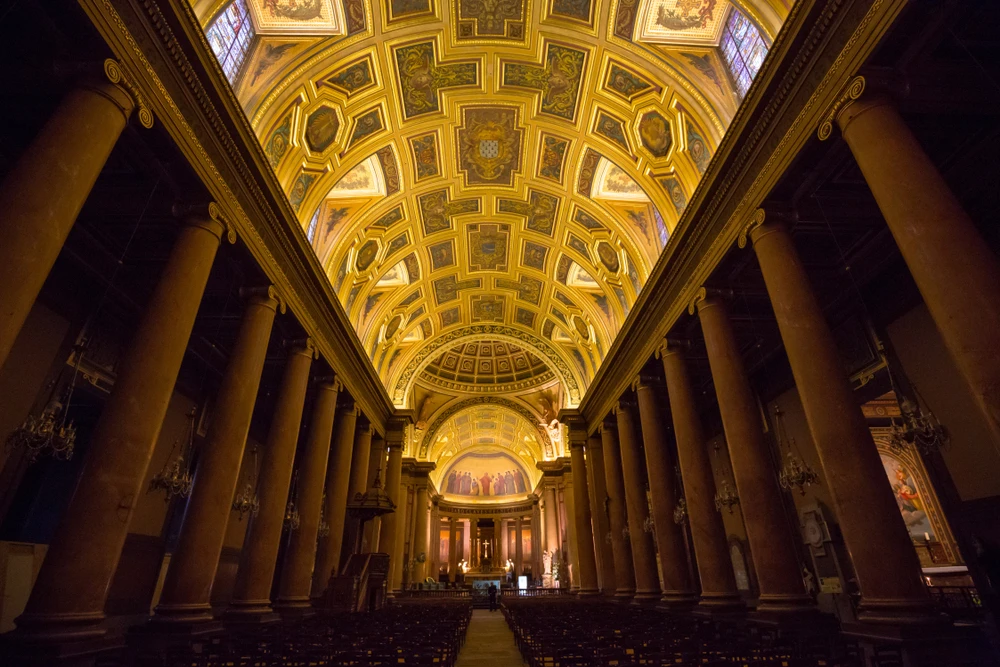 In the Cathedral of Rennes / Photo by Joost Adriaanse/Shutterstock
In the Cathedral of Rennes / Photo by Joost Adriaanse/Shutterstock
The interior dates from the 19th century, it was built after the demolition of the old cathedral near collapse. Amazing interior with its columns that seem to be made of marble when, due to lack of means, they are made of granite and painted with stucco made of chalk, lime... And ox blood. The ambulatory of the choir is painted with a cohort of Breton saints by dioceses. We see among others Saint-Malo, Saint Enogat, Saint-Brieuc... Around the Cathedral, don't miss the Mordelaise gate, the place where the Dukes of Brittany passed through on their way to their coronation, the House of Dugesclin, with Saint Sebastian carved in wood, pierced by an arrow and an archer. The funny thing is that the arrow that pierces Saint Sebastian... Comes from the opposite side of the archer. Also to be seen not far away is the Hotel de Blossac, magnificent and so typical of the Renaissance for one part and of the Age of Enlightenment for the other part, the Saint Yves chapel (where the tourist office is located) and the small streets of old Rennes.
4 the Place du Champ-jacquet
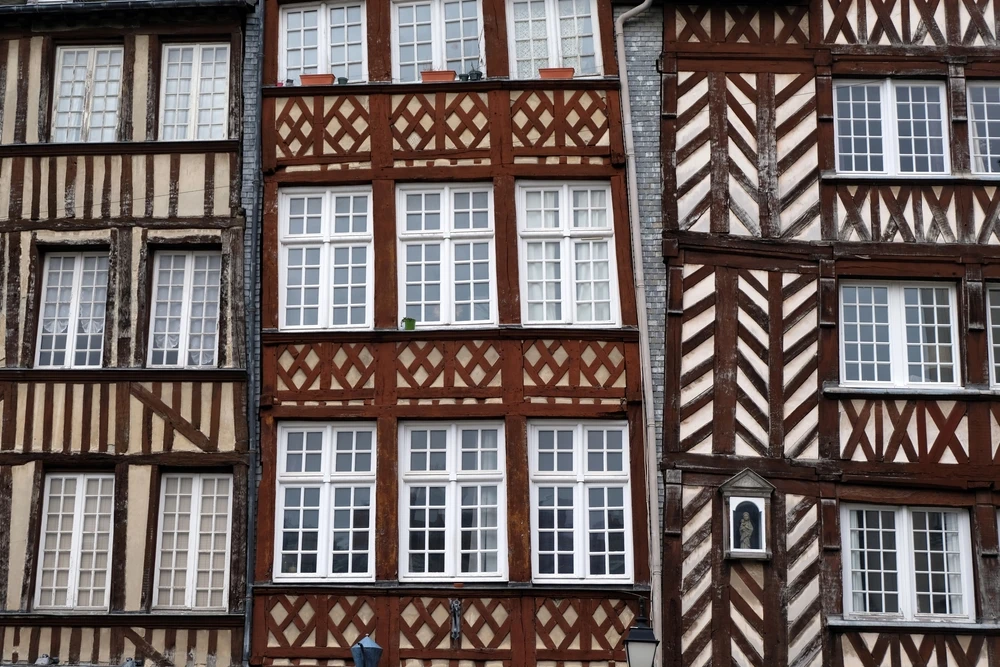 Rennes : Place du champ-jacquet / Photo by RVillalon/Shutterstock
Rennes : Place du champ-jacquet / Photo by RVillalon/Shutterstock
This is the "Pisa" of Rennes, as you can see the 17th century houses all leaning and quite funny to see. They are however much more solid than they look since they have been standing like this since the middle of the 19th century.
5 the thabor
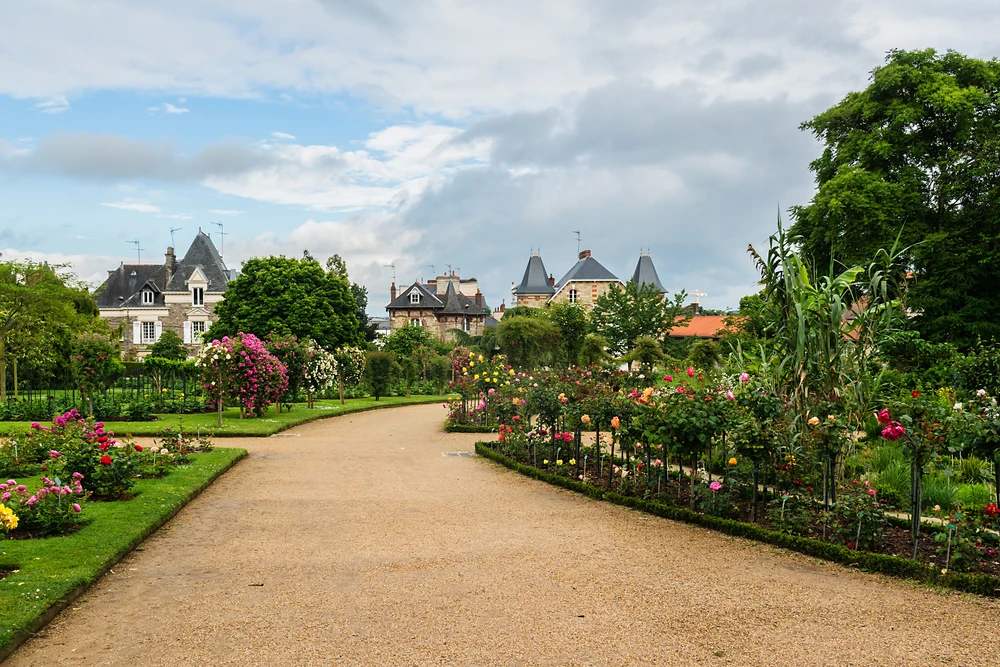 Rennes : Le Thabor / Photo by Kiev.Victor/Shutterstock
Rennes : Le Thabor / Photo by Kiev.Victor/Shutterstock
Magnificent park created in the 19th century and green lung of Rennes. It aligns beautiful alleys, some beautiful sculptures and it's nice to go there after seeing the Notre Dame en Saint Melaine church, whose roots go back to the early Middle Ages, and which is one of the oldest buildings in the city.
But you must also see.
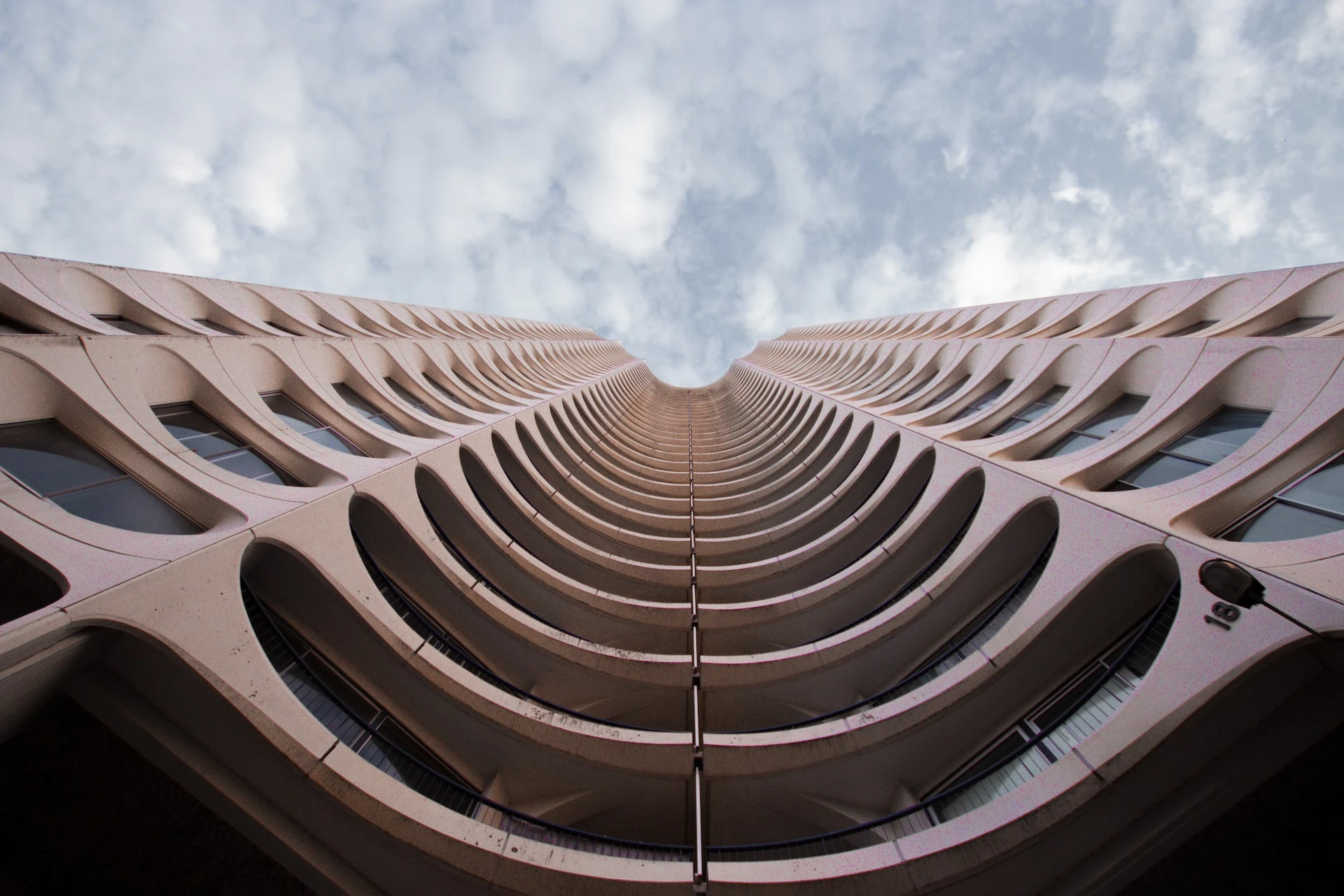
The tower of horizons. Detail Photo by Baptiste MG on Unsplash
The Horizons tower with its 99,50 and its modern and beautiful facade is the highest monument of Rennes. The Saint-Georges swimming pool completely Art Deco and its mosaic decoration. The Saint-Georges Palace, former Saint-Georges Abbey. The "champs-libres" (free fields), which gather the Library of Rennes and the Museum of Brittany. You can also discover a planetarium.
3 things to do in Rennes
1 Have a drink!
On the terrace, it's the best, you can't not find a place to have a drink or a coffee. The top is Place des Lices, Place du Champ-Jacquet, Place Saint-Michel, but also in the cafés of rue Saint-Michel, rue de Saint-Malo, or rue Saint-Georges. The area of rue Vasselot is also nice. Have a party! In Rennes, it's normal. It's even a way of life.
Photo by Michael Discenza on Unsplash
2 Stroll around the market of the Lices
On Saturday mornings, between the market halls and the exhibitors on the square, you'll come across all the flavors of Brittany, and it's a whole atmosphere to discover. Taste a good sausage cake, and have some oysters with a white wine to take home.
3 tasting a "galette"
 Typical of Rennes and Brittany: galettes and crisps / Photo by Javier Garcia Seijas/Shutterstock
Typical of Rennes and Brittany: galettes and crisps / Photo by Javier Garcia Seijas/Shutterstock
Brittany is the land of pancakes. We say "galette" when you want it salty, and "crêpe" when you want it sweet (with chocolate is great! Or with apples flambéed in calva). To discover its charms, try the "complete" one: with ham, Gruyère cheese and a fried egg and a little salad on the side. It lends itself to everything, this galette. We make it with mushrooms and cream, with raclette... In fact, in the past, we used to put everything we could find as leftovers. This explains why so many people in Rennes still eat "la galette" on Fridays, a day of lean food for Christians. The sausage cake is also emblematic of Rennes, it can be found on the market, in the stadium, in popular events... It is a kind of hot dog, made of a sausage covered with a little mustard and around which a patty is wrapped.
Links and geo information
The website of the tourist office of Rennes
Rennes is located at 350 Kms from Paris (3H30 of road / 1H30 by train) 100 kms from Nantes (1 hour of road), 65 kms from Saint Malo.
The airport of Rennes Saint Jacques offers national and international destinations, but the most important international airport is that of Nantes at 100 Kms.
It has 215,000 inhabitants and the agglomeration, named Rennes Métropole, has 457,000.
Dear reader attention! There may be some translation errors. Our translator partied in Rennes all night. We lost him near the Rue Saint Michel and he is still not back so ... We did what we could with the trainee who speaks Spanish!

